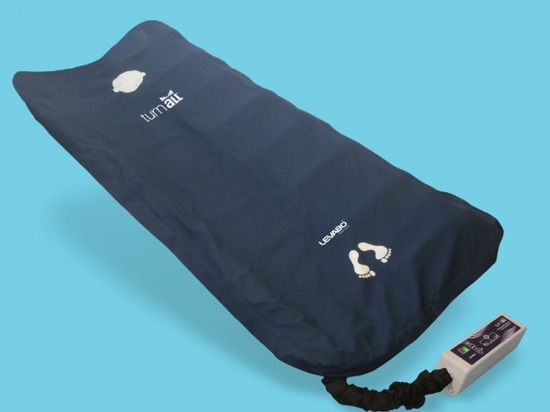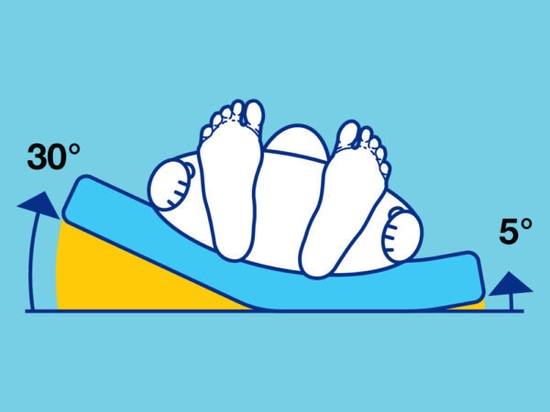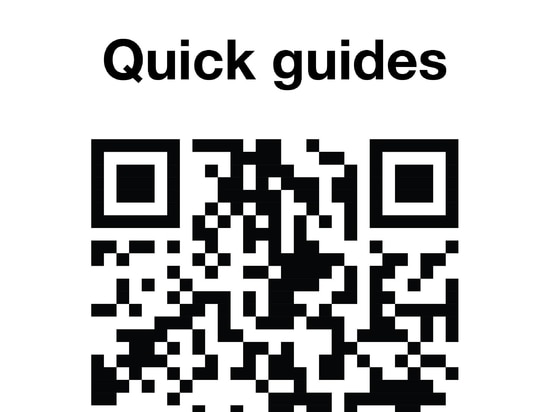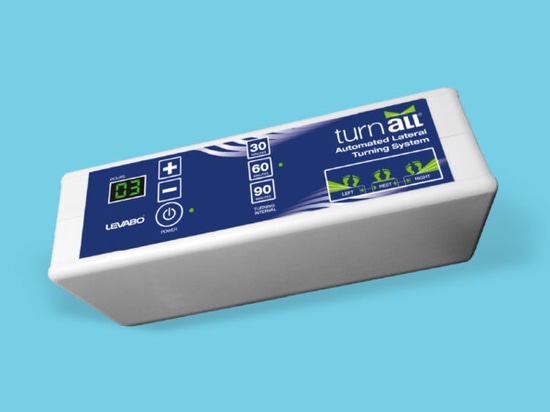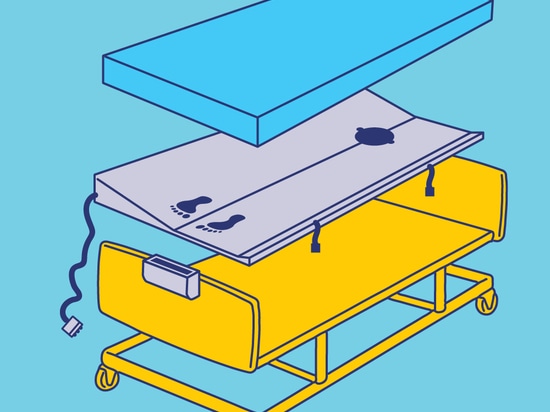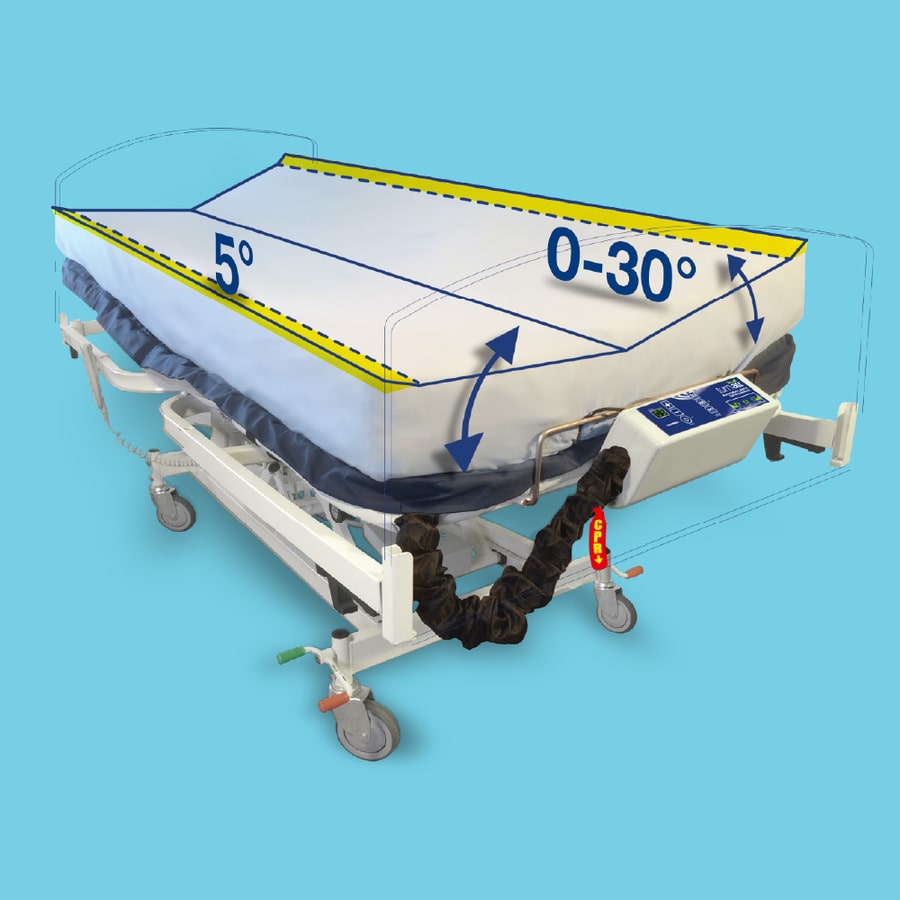
#Product Trends
New Automated 30° Lateral Turning System - the 'Turn All'
Partial automation in patient positioning with the Turn All® System.
Automated anti-decubitus system with 30° lateral position for prevention and treatment of pressure ulcers.
As in all areas, partial automation creates a great advantage for employees in labor-intensive work. Due to many factors, this aspect is becoming increasingly important in everyday nursing care. In addition to the necessary care of the patient, it is also a matter of protecting the nursing staff. Levabo has developed the TurnAll system for this purpose.
The TurnAll® system transforms a standard bed into an automatic side positioning bed. TurnAll fits into any standard bed, where it is placed under the existing mattress. It can be used with dynamic mattresses and height-adjustable beds. The system turns the patient automatically, smoothly and quietly, reducing the need for manual intervention by caregivers. This protects against physiological disorders in the caregiver and also saves time provided to the caregivers on the patient.
This cost effective system has been designed to be used in Acute and Community Settings (including patients' own homes). It provides automated 30° lateral turning which can result in improved sleeping patterns for patients and reduced manual handling requirements and associated care costs. The 'Turn All' aids in the prevention and treatment of Pressure Ulcers and is very simple to set up and use.
TurnAll was designed with the most important aspects of patient care in mind. The international guidelines published in 2019 (Prevention and Treatment of Pressure Ulcers/Injuries) by EPUAP, NPIAP and PPPIA recommend the 30-degree lateral position for patient positioning. TurnAll was developed in accordance with these guidelines and in collaboration with hospital professionals. It was developed for the control of pressure ulcers worldwide.
Traditional prevention methods by manual repositioning versusautomatic repositioning:
The traditional way to avoid the formation of pressure ulcers is for a family member, caregiver, or institutional worker to regularly turn the patient (it is recommended that this be done every two hours) and stabilize the patient in a new position to relieve tissue compression and restore blood ow.
This has to be done around the clock, and unfortunately this manual process has a significant number of disadvantages that include:
1. The immobilized patient is awakened at night by the repositioning process
2. Caregivers, family members or institutional staff may suffer serious back injuries from the lifting effort
3. Caregivers or family members must be present 24 hours a day and this can lead to severe insomnia and severe emotional stress
4. In institutional settings, the need to frequently immobilized patients expensive, both nancially and in terms of staff time consumption
5. The patient may be in a home environment where family members are unable to physically give the necessary regular turn
6. If there is no support at home, it may be necessary to relocate patients to a place that leads to loss of privacy, dignity and inability to create a life other than institutional living.
In the automated repositioning process, the patient is placed on his back in the middle of the bed. When the Turn All® lifts one side evenly and quietly, the outer part of the mattress is lifted up on one side and forms a "wing" that supports the body in its entire length from the ankle to the shoulder.
A slight lifting of the opposite side of the mattress is done to prevent slipping and shear forces that may increase the potential for developing pressure ulcers, this provides support and reassurance for the patient.
The patient is carefully rocked by the structure of the mattress to prevent pressure ulcers. Any pressure transmitted to this side by the user is distributed along the entire body.
When Turn All® reverses the rotation, the higher "wing" is lowered so that the mattress is in a horizontal position.
Turn All® then automatically switches to the other side to complete the cycle.
Benefits for institutions:
• Increased productivity of nurses and auxiliary staff by reducing the amount of manual turning of patients required. This allows employees to spend their time more efficiently and productively in the
care of their patients
• An effective way to treat or avoid pressure ulcers and other complications of immobility
• Equipment can be used with existing beds, Turn All® can be integrated into any care bed with removable mattress.
The installation itself is simple, can be performed by the caregiver and takes a few minutes.
• A method of protecting healthcare professionals from debilitating back, neck and shoulder injuries
(caused by moving or turning patients), leading to significant absenteeism from work and the associated costs of sick days, workers' claims and the hiring of replacement workers.
• Reduced staff turnover, reduces the cost of recruitment, employment and training and by using more expensive temps.
Benefits for patients:
• The automated repositioning process allows for more frequent repositioning to address pathophysiological events associated with immobility.
Also referred to as kinetic therapy, this reversal not only provides pressure relief to prevent or treat pressure ulcers, but it can also produce, for example, a dramatic reduction in the incidence of respiratory problems and urinary tract and bladder infections.
• Significantly better sleep quality, as the patient does not have to be turned manually at night, and is not woken by Turn All® when the patient is turned. This creates better mental clarity, better health and an improved lifestyle, free from dependence on caregivers at night (5). • The possibility of living in the home instead of an institution
• Pain reduction - Even heavy patients are positioned gently
• Better blood circulation Turn All® can still reposition when the torso is in the raised position up to 20°. This is a significant benefit for people who receive tube feeding.
• Prevention or reduction of gastroesophageal reflux
• Better respiration and release of upper respiratory tract and oral secretion (6).(7).(8). • Reduction in spasticity and abnormal muscle tone - improved comfort
• Improved bowel regularity
• No dehydration and subsequent electrolyte balance, as Turn All® does not create heat
• Side support system: Slight lifting of the mattress, on the opposite side of the primary lifting side, provides support and reassurance as well as decreases the risk of shear.
"Cost benfits for the healthcare industry:
For an industry struggling to control its costs, Turn All offers
signficant savings by focusing on a strategy to prevent problems
before they occur. It offers:
• Signficantly reduced direct medical expenses associated with repeated
hospitalizations to treat pressure ulcers and other complications of immobility
such as bladder and respiratory infections. It is estimated that pressure ulcer
prevention is 9-10 times cheaper than treatment - Dealey Report (2012)
• Support for a de-institutionalization strategy that makes it possible to move
chronically immobilized patients from hospitals back to their homes (or to
assisted living environments)
• Avoid expensive readmissions from pressure ulcers or other
systemic complications
• A method of reducing the length of hospital stays for specific groups of
patients. Treatment of critically ill patients with kinetic therapy has been
shown to reduce intensive care by 24 percent. The movement helps reduce
the risk of infection and complications from pneumonia and other respiratory
problems affecting approx. 20 percent of intensive care patients.
• A 1987 study published in the journal Stroke found that the risk of infection
for patients with stroke placed on normal hospital beds was 2.9 times greater
than a study group of patients placed on automatic reversal systems.
(Stroke 18, No. 3 May -June, 1987).
• Signficantly reduced costs of claims for nursing staff and support staff
injured during repositioning or transfer of immobilized patients. A survey
conducted by the Workers' Compensation Board in British Columbia in
1996 found that manual lifting, transfer or relocation of residents (without
the help of mechanical helpers) was responsible for 63% of all back, neck
and shoulder injuries.
• Signficantly reduced time lost by nursing and support staff from neck, back
and shoulder injuries. Reduces finding problems replacement staff.
• Signficantly reduces the number of employees involved in turning patients
(especially at night). This will reduce the cost and do it enable staff to focus
on delivering a signficant higher quality of care."
ROI - Return of Investment
Pressure ulcers and repositioning
Monetarily, pressure ulcer treatment is much more expensive than pressure ulcer prevention in a healthcare system already under financial pressure.
According to American studies, the average cost of a pressure ulcer incurred during a hospital stay is approximately 33613,-€ (1). There are no current figures on how much pressure ulcers cost German society. The associations estimate that the follow-up costs amount to at least approx. 2.5 billion euros. The additional treatment costs due to pressure sores in Germany are estimated at approx. 4,550€ up to 19,500€. ( see Eberhardt S., Heinemann A., Kulp W. et al. 2005, p.32 )
Frequent repositioning in the 30° lateral position is more cost-effective than less frequent repositioning in the standard 90° position because it reduces nursing time and improves nursing outcomes (Moore et al. 2011).
A randomized controlled trial demonstrated the effectiveness of repositioning patients every three hours overnight in a 30° position compared to patients who were repositioned every six hours overnight but were side-positioned in a 90° position at each repositioning. (Moore et al. 2013). (3).
Pressure ulcer treatment is so expensive that if the Turn All® System only prevents one Category 1 pressure ulcer, the system has already paid for itself.
If you want to calculate your pressure ulcer costs, try the Levabo Calculator at:
www.levabo.dk/wp-content/uploads/2018/08/Prevention-VS-Treament-GB-Calc.pdf
If you have patients who need to be repositioned every other hour of the day, regularly at a cost of about 15-20 minutes, TurnAll will save you 3-4 hours of nursing time. In such a scenario, the system will pay for itself in about 10 days.
